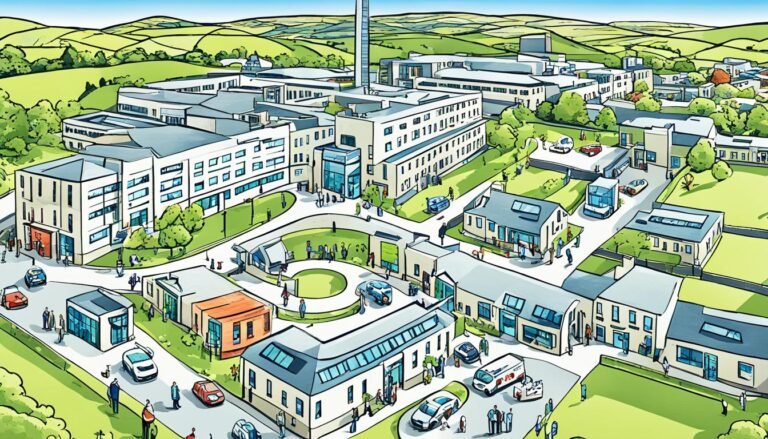Healthcare Reforms in Ireland: Progress and Challenges
Did you know that private health spending in Ireland hit €963-969 million in 2019? This shows how more people are turning to private care, even as the government works towards universal healthcare. Ireland’s healthcare system is going through big changes to improve care and policy, facing tough social and economic issues.
The Sláintecare program is at the center of these changes. It’s a ten-year plan to bring universal healthcare to Ireland. It started during the economic crisis, marking a big change in healthcare policy and how resources are used. Thanks to these reforms, over 22,000 new healthcare workers joined the field in just three years.
But, there are still big hurdles to overcome. Ireland faces issues like medicine shortages, not enough staff, and a growing older population. The Sláintecare plan for 2021-2023 outlines these goals, focusing on how eHealth can help improve care. Ireland’s Department of Health is working on a new strategy for a unified health information system. The aim is to make public and private healthcare work better together.
Key Takeaways
- Private health expenditure in Ireland was approximately €963-969 million in 2019.
- The Sláintecare program aims to achieve universal healthcare over ten years.
- More than 22,000 new health workforce staff have been added in the last three years.
- Challenges include medicine shortages, staffing issues, and an aging population.
- The importance of eHealth in fostering integrated patient care is highlighted in the latest strategies.
Overview of Healthcare Reforms in Ireland
Healthcare reforms in Ireland have been a big topic for over ten years. The main goals are to make healthcare more accessible and affordable. They also aim to tackle the complex issues the system faces.
Historical Context
The economic crisis in 2008 had big effects on Ireland, including cuts in health spending. From €15.4 billion in 2008 to €13.6 billion in 2013, public health funding dropped. The country’s gross national product also fell by almost 20% from 2008 to 2011.
This economic trouble led to many reforms to make healthcare more efficient and cheaper. For example, spending on medicines and staff was cut. The ‘money follows the patient’ model was introduced to better use resources.
Current Status
Today, Ireland’s healthcare reforms are still changing. Waiting times for hospital treatments varied a lot from 2021 to 2022. This shows there are still issues with getting healthcare.
Even with efforts to make services better, healthcare costs keep going up. The National Treatment Purchase Fund (NTPF) helped some patients wait less, but not all. By 2012, about 24.5% of the population was struggling financially.
In short, Ireland’s healthcare reforms are trying to make healthcare better and cheaper. They face many challenges but keep working to improve health policy.
Universal Healthcare Goals in Ireland
Ireland has always aimed for universal healthcare, a dream that has grown over time. The Sláintecare Program is a key part of this goal. It was created by the Department of Health to make healthcare fair and easy to get.
Sláintecare Program
The Sláintecare program started in 2017 with a big goal: to make Ireland’s healthcare universal. It plans to improve healthcare in many ways. This includes making general practitioners and primary care universal, moving private care out of public hospitals, and lowering costs for patients.
The program also wants to increase public spending on healthcare through taxes. It suggests a single-tier, multi-payer model of health insurance. This means every person would get a health insurance policy from a provider they choose. The government would help pay for these policies through a fund.
Government Initiatives
The government is doing more than just the Sláintecare program to improve healthcare. For example, the European Health Data Space aims to make sharing health data across the EU better. This plan was approved in May 2022 and is now being discussed in detail.
Ireland is also investing in digital health to make healthcare better. By improving technology and digital tools, the government hopes to make healthcare work smoother for everyone.
Together, these reforms and the Sláintecare program show Ireland’s strong commitment to universal healthcare. They aim to make sure everyone gets quality healthcare that includes everyone.
Recently, the White Paper on Universal Health Insurance and the Programme for Government (PfG) outlined how to achieve these health reforms. The goal is to have a unified, efficient healthcare system by 2019. This will change many health services and improve Ireland’s healthcare.
Progress and Challenges in Achieving Universal Health Coverage
Achieving universal health coverage (UHC) is a key goal for Ireland’s healthcare. The journey has seen big steps forward and tough challenges. We’ll look at the progress and the hurdles left.
Progress Made So Far
Ireland has shown a strong commitment to UHC with many changes. The Sláintecare agenda has been a big step forward. It aims to improve patient access and quality of care.
Key actions include making universal GP and primary care services available. It also means cutting down on out-of-pocket fees and boosting public healthcare spending. These efforts show Ireland’s push for a top-notch, publicly funded healthcare system.
Remaining Challenges
Even with progress, Ireland still faces big hurdles in achieving UHC. One big challenge is figuring out what UHC fully means. Questions surround how user charges and private health insurance will fit together.
With a big private health insurance market, there’s debate on its place in a universal system. Also, Ireland needs to increase public healthcare capacity and spending. This is crucial to ensure everyone has access to healthcare. Overcoming these challenges is key to reaching Ireland’s healthcare goals.
Impact of Economic Crisis on the Irish Healthcare System
The economic crisis of 2008 hit Ireland hard, making us rethink healthcare. Since then, public health spending has dropped by about 9%. This led to a tough time for healthcare, forcing hard choices to keep quality care going.
The crisis changed how Ireland used its health funds from 2000 to 2013. The share of public spending on health changed a lot from 2007 to 2014. This made healthcare providers work harder to keep care quality high despite less money.
Inpatient, emergency, and day case services had their own trends from 2008 to 2012. These trends put a lot of pressure on the system to keep up care quality. Yet, Ireland made changes to keep healthcare strong.
During a tough financial bailout from 2010, Ireland got €85 billion from the EU, IMF, and ECB. This led to cuts but didn’t affect healthcare access or quality.
The economic struggles led to six austerity budgets until Ireland came out of recession in 2014. Most of healthcare funding came from taxes, about 70%. But, this meant cutting some healthcare services, which affected care quality.
This tough time also made nurses insecure in their jobs and doctors left the country. The lack of medical supplies made work hard for healthcare workers. This hurt the system’s strength and care quality.
Despite these challenges, the hard times pushed for new ways to give healthcare. This set the stage for future changes to make healthcare better and fairer in Ireland.
Access to Healthcare: Current State and Future Directions
In Ireland, there are big differences in healthcare access between public and private options. There are also big differences across different areas. The goal is to make sure everyone has equal access to good healthcare, but there are still big challenges.
Public versus Private Healthcare Access
There’s a big debate on whether public or private healthcare is better. Public healthcare tries to offer services to everyone, but it often falls short. This makes people turn to private healthcare for better quality or speed.
Private insurance costs are going up, making more people rely on private care. This is especially true for those who want better or quicker care.
- Out-of-pocket payments account for 15% of health spending.
- Voluntary health insurance covers 12% of expenditures.
- About 70% of healthcare funding is publicly sourced.
These numbers show how big a role private healthcare plays in Ireland. Even with efforts to close the healthcare gap, not everyone can get free GP Visit Cards. This means not everyone has equal access to healthcare.
Geographical Disparities
Healthcare access varies a lot depending on where you live in Ireland. Rural areas often have less access to specialist care and longer waits. This is because there are fewer healthcare facilities and professionals in these areas.
There are plans to fix these issues. The Department of Health is working on:
- Expanding community care services.
- Improving connections between regional health services.
- Investing in healthcare infrastructure in less served areas.
The goal is to make sure healthcare is the same everywhere. This means everyone, no matter where they live, should get the healthcare they need.
Healthcare Costs and Funding Issues
Rising healthcare costs and funding issues are big problems in Ireland’s healthcare system. Managing healthcare funding well is key to keeping the system running and improving patient care.
Public Expenditure Trends
Public health spending in Ireland has changed a lot over time. In the mid-20th century, it was less than 2% of the national income. By 2000, it had grown to just under 6% of national income. By the pandemic, it reached about 8%.
Ireland saw a faster increase in healthcare funding compared to other OECD countries.
Recently, the government has spent more on healthcare due to rising staff costs and more people needing services. Over three years, Ireland hired over 22,000 health workers. This shows a big increase in public spending. Ireland also spends a lot on healthcare, ranking 6th among 33 OECD economies.
Funding Mechanisms
Ireland uses different ways to manage healthcare costs. Hospitals were behind a €264 million annual overrun from 2015-2019. Community primary care and the primary care reimbursement service added €148 million and €95 million, respectively.
Even with rising costs, there’s a push for cost-efficiency in healthcare. Up to 18% of GP visits are for minor issues, offering a chance to cut unnecessary visits. Using technology and sharing resources can also make the system more efficient.
The European Health Data Space is a new effort to share health information across the EU by 2024. This could improve healthcare.
The Mazars Working Group is looking at how to improve the process of getting new medicines in Ireland. This is important for getting new treatments quickly and dealing with high drug costs.
Ireland expects healthcare spending to go up from 8.3% of GNI* in 2019 to 13.2% by 2050. This is due to more older people and changes in the population. To handle this, we need to keep improving how we fund and manage healthcare costs for a sustainable future.
Innovations in Medical Treatments and Drugs
Ireland is leading the way in healthcare with big steps in medical innovations. These include new treatments and drugs. They are vital for tackling health issues like chronic diseases, heart disease, stroke, and cancer.
Investment in New Therapies
The Irish Pharmaceutical Healthcare Association is focusing on new therapies. They want to create a great place for research and development. This way, Ireland can lead in medical innovations.
More investment means more groundbreaking treatments. It also means making these treatments available to more people. The Health Services Healthy Ireland Implementation Plan 2023–2027 highlights the need to add these new treatments to healthcare.
Regulatory Challenges
New therapies are exciting but come with regulatory hurdles. It’s important to make drug regulation quick and efficient. This helps bring new treatments to patients faster.
The Medicines and Healthcare products Regulatory Agency (MHRA) is doing well. They’ve reviewed over 2,000 clinical trial applications in 60 days. But, we need to keep up the good work to handle the growing number of new treatments.
Healthcare Workforce: Expansion and Challenges
In recent years, Ireland’s healthcare industry has grown a lot. It hired over 22,000 new professionals to improve patient care. This growth is a big step towards meeting patient needs and improving services.
Workforce Expansion
The growth in Ireland’s healthcare workforce matches global trends, especially during the COVID-19 pandemic. Countries then used many strategies to increase their health workforce. These strategies included quick training programs and moving staff around.
Even with these efforts, job quality has gotten worse. This has made many healthcare workers leave the country, as shown in Human Resources for Health.
Staffing and Retention Issues
Expanding the workforce is important, but keeping staff is a big challenge. A study found that medical supply shortages and burnout affect worker morale. The International Journal of Human Resource Management also looked at how job insecurity affects nurses.
To solve these staffing issues, Ireland must focus on improving job quality and working conditions. This will help create a stable, skilled healthcare workforce ready for the future.
Source Links
- Sláintecare implementation status in 2020: Limited progress with entitlement expansion
- THE NEED TO REFORM IRELAND’S NATIONAL HEALTH INFORMATION SYSTEM
- The Challenge of Healthcare Reform
- Improving access to healthcare in Ireland: an implementation failure | Health Economics, Policy and Law | Cambridge Core
- The impact of the crisis on the health system and health in Ireland – Economic crisis, health systems and health in Europe
- Tough medicine in 2024 for Ireland’s struggling healthcare system
- TOWARDS UNIVERSAL HEALTHCARE IN IRELAND – WHAT CAN WE LEARN FROM THE LITERATURE?
- Universal health coverage evolution, ongoing trend, and future challenge: A conceptual and historical policy review
- The impact of the financial crisis on the health system and health in Ireland
- Implications for health system reform, workforce recovery and rebuilding in the context of the Great Recession and COVID-19: a case study of workforce trends in Ireland 2008–2021
- Department of Health OGP Annual Report 2022
- Health services healthy ireland implementation plan 2023 – 2027
- Government used COVID to progress health reform – Health Manager
- What we’re doing to speed up clinical trials in the UK – Department of Health and Social Care Media Centre
- Priorities and challenges for health leadership and workforce management globally: a rapid review – BMC Health Services Research








